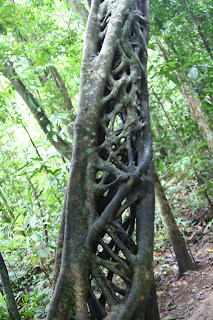From Bondi Beach and the Opera House in Sydney to the wheat fields and vine yards of Adelaide to the desert and wild camels of Uluru to the coconut palm and sugar cane fields north of Cairns - Australia is a country that is defined by contrasting climates and vegetation.
We travelled from Uluru to Port Douglas, which is about 85 kms north of Cairns, on the north east coast. Port Douglas is pure tourist town and sits on the edge of the north Australian rain forest, which is the oldest rain forest in the world.
 |
| Strangler Fig, after it has killed the host tree |
 |
| Umbrella Palm, one leaf |
 |
| Mangrove swamp |
About an hour and half north of Port Douglas the heritage forest is uninhabited, but does have a number of folks that live along its edges. Some are resort or tour owners and workers, some just like the lifestyle. And what a lifestyle, as one resort worker woke up in the morning with something cold in bed with her only to discover a 3 meter python had moved in to keep warm. As there is no electricity, hence no air conditioning, and the temperatures are in the mid 30s year around I guess it is common for slithery creatures to move into the homes at night. Not for me, I will stay in Port Douglas where the only things I have to worry about are mosquitoes, sand flies and the odd crocodile.
As Port Douglas and the rain forest are close to the great divide of Australia there are lots of fresh water creeks and estuaries along the coastline. These creeks and water ways are home to Australia's salt water crocodiles, which are the largest crocs in the world. These "beasties" inhabit murky water and can lay submerged watching the victims habits for some time. They feed mainly on wallabies, feral pigs, calves and foals. Now protected, they do raise heck with some of the cattle farms along the creeks and once in awhile a farmer will go on a shoot and bury mission. There are a number of tour operators that will take you on a river boat trip looking for crocs, but again the warmer months from October to April make it harder to find them as they can lay submerged in the warm waters and do not need to come out on the banks to sun themselves as much. We were lucky to find one female out sunning.
 |
| Watching us for prey |
They will attack humans, and one tragic story is of a young couple that ran a crocodile tour boat who lost their five year old son to a croc during a flood that raised a creek behind the house too high. The young lad and his older brother, unknown to the parents, were wake boarding into the creek from the back steps of the house.
This north east corner of Oz below the rain forest is amazing in the crops that grow here. Sugarcane (one of the top ten sugarcane producers in the world), banana, coconut, macadamia nuts, tropical fruits, and tea. This all in a two thousand kilometer band along the coast from Brisbane north to the jungle. Port Douglas was once jungle also but completely cleared for sugarcane farms. Elsewhere in Australia they also grow citrus fruits, rice, tree fruits, coffee, and the list goes on.
 |
| Banana |
 |
| Tea |
Yesterday while walking the beach adjacent to a golf course, this sign was posted. "Use caution, crocodile sighting here yesterday, if you see any activity please report to the authorities". We never saw any activity, but I did try and get Loreen to cross the creek first!

No comments:
Post a Comment